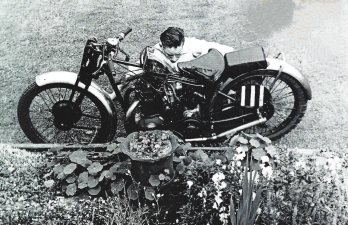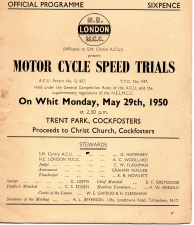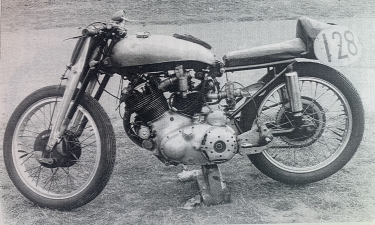
As told exclusively to Alfred Joseph Hagon will be best known to readers of these pages as the dominant force in motorcycle Sprint and Drag Racing in the 1960s. Many will also be aware that his prowess in designing, building, riding and racing bikes in many different areas of motorcycle sport was equally prolific. Add to this his success as a frame , engine and bike builder and his accomplishments as a business man catering for the two-wheeled market, and it’s no surprise that his name is still known and revered throughout the motorcycling world today. Our five part interview and review of Alf's long career includes archive media. Thanks to Alf for taking part, and to Chris Dossett for his research and transcribing Alf's story. Part one of Alf’s story covers his early life and his first experiences with motorcycles and their modification. His first jobs began with carpentry and glass work before finding his place in engineering, which led to him constructing his own bike frames in his lunch breaks. He recalls his first competition outings in trials, scrambling, motocross and grass track racing before becoming involved in Speedway, a sport where he would gain a highly regarded reputation as a top competitor and bike builder during a relentless and punishing schedule where he was very much in demand. Alf’s first impressions of the idea of Drag Racing were less than favourable but he soon became involved in sprinting, appearing at meetings alongside the master of the sport George Brown, before accepting a ride on Gordon Calquhoun & Charlie Rous’ Vincent that caught the attention of the established sprint fraternity. I was born in 1931 in Ilford, Essex. I tried my first drink of rum and a cigarette at the age of 10 and didn’t like either, I’m not a drinker or smoker. My motorcycle career goes back to when the war was still on. Me and my mate had an old 1928 Ariel Colt with no mudguards, and went over the fields and just messed about on it. One day a policeman comes walking across and says “Where did you get the petrol to run that on?” I told him we were not running on petrol, we were running on dope. He said “Don't be cheeky!” I said “It’s what they run the speedway bikes on, it’s Methanol.”
Just after the war I was 15 and went to the motorbike club, and I would catch a lift as the pillion. Sunday we were going up the Southend road. There's a grudge race between this bloke Pat and someone else. One guy’s got a new Tiger 100 with tele forks but rigid frame, and the other guys got a 1933 Rudge. We go out on the Arterial Road at the Halfway house roundabout, going half a mile up the road. In those days you had an intersection in the middle of the dual carriageway and turned round on the intersection and a cycle track. So there's about 20 of us and we parked the bikes in the middle of the road and on the side. These 2 guys would go down to the roundabout then race up past us. You wouldn’t believe it but there was just no traffic about then. The Rudge won by about 100 yards. About a year after the war ended I was just turning 16. Petrol was on ration, then came off, then very quickly went back on. My friend's brother had a motorbike and we would go to the motorcycle club. One evening at the club a guy came round and said “We’ve got a grass track on Sunday, who’s going to help?” I said "Can I ride at the Grass Track?", "Yes, you can ride” he said. At the time I had a 1937 250cc New Imperial. It had a single spring with a friction damper rear suspension, unit construction. It was a real good thing but absolutely nothing worked on it. Anyway I rode at that meeting which was the last Grass Track event in 1947. I got rid of the New Imperial and brought a 1933 350cc 4 valve Radial Rudge. I rode that in the Lambourne Grand Nationals Scramble, must have been 1948. It had girder forks and a rigid frame, which 99% of the bikes were pre-war. The Matchless had tele forks on, then the rest of the British bikes put tele forks on. I didn’t have a bike on the road. I worked at a small engineering firm and used to go there on my pushbike. My Dad ran a London Taxi and had a car as well, a 1937 Jowett.
I did a couple of years Grass Tracking and then did Trials, Scrambles, Motocross. I rode the last Brands Hatch Grass Track before it was tarmacked and went down to see the facility being built. I think this was 1950. In Grass Track you had to qualify and go through your heats to get to the final, and I came 5th in the 350 final. Then I did the first Brands Hatch Road Race on the Rudge. By this time I had tele forks and I’d got a rear suspension that I brought and modified. A couple of the local motorbike dealers, Tom Kirby and Johnny Double, got quite involved in the Road Racing. Tom sponsored Mike Hailwood and another guy. The competition bike was just a road bike with a 21 inch front wheel, big rim on the back, a different tank, exhaust pipe and mudguards. My first success was a Hill Climb at Polstead near Colchester, and I won that on the 350 Rudge. Then I started winning finals and things.
I did Motocross then, I rode in the National Scrambles at Shrublands Park on a 250 Triumph. I finished 3rd, I think in the 250 class. I bought and put tellies on it, fiddled with the engine and had a sprung hub in the back. Disaster they were. I rode in 1950 at the Trent Park sprint with George Brown and Francis Williams and I had my 350 Rudge. George Brown was the guy to beat. Gordon Colquhoun had Colqustones just the other side of the Blackwall tunnel, they made a rear suspension. I took my Rudge to have a rear suspension fitted but when I got it back I found it was out of line so sent it back to be corrected. Then Gordon built a Vincent and Charlie Rous, who was the top guy at Motorcycle News, rode it and tried to beat George, without much success. Len Cole came in and talked about Drag Racing and I said “What a waste of time!” Then I was asked to ride Gordon’s bike because Charlie was not available. We took it to a Sprint and I first did a clutch start in bottom gear. I said “Why not start in 2nd gear?” but they didn’t want me to. Len was there and for my first run, on a cracked tarmac track, did a normal start and did my run. On the line George Brown turned to Len and said “That’s not the way to ride a Vincent!” Then the time came up and it was the fastest time of the day. (11.28s, a new course record)
With George we always used to go up to him and just wind him up. He was a funny bloke and I got on alright with him. One day I said to George "Why don’t you use a Vincent centrifugal clutch?". "I’ll tell you why I don’t use a Vincent centrifugal clutch, there's not enough beds in Stevenage hospital!" Apparently if the motor seized up you couldn't disengage the clutch. In the meantime I was doing Grass Track. I’d got rid of the Rudge and I had 2 B32's. They were 350 BSA, tele forks, rigid frame and with them, all in bits, was a Speedway JAP engine. So I put the 500 JAP in the BSA frame and I got Deeprose rear suspension put on it. They made their own tele legs on the back and for oil seals they used hemp. For the first meeting the shocks hardly went up and down at all, The second meeting they worked alright and the third meeting they blew all the seals. That was my introduction to the rear suspension and the legs. Then I fitted a 350 JAP in the other one so I had 2 BSA's, one with a 500 the other a 350 JAP engine. Then I started to run in a National Championship once a year at the Kirkby Mallory Road Race track. That was a grass track, originally a pony trotting track, about 7 eighths of a mile round. The fence on the inside was those big white wooden posts and rails, and you’d bomb round the outside of that. They ran it for a couple of years. In 1953 I won the 350 and 500 National Championship on the BSA JAPs. I still hold the record at Kirkby Mallory Grass Track. Then, I think it was Grays Grass Track, Stanford Le Hope, there were a couple of mechanics from Harringay Speedway there. On my way home from work I would call in Smith and Doubles motorbike shop and speak to the guys. Johnny Double asked me if I was interested in Speedway. I said "I’ve watched a couple of meetings", he said, "Harringay wants to give you a trial". I went to Harringay in February 1953 on one of my 350 BSA’s I was using in Trials and going back and forth to work on. I thought I’ll ride the bike to the Speedway, and in those days nobody wore a crash helmet. It had no lights but you could ride a bike with no lights on the road then. I’d never sat on a Speedway bike, the team manager was Wal Phillips, he did all the development work on the JAP speedway engine. He rode at Brooklands and was one of the first Speedway riders in the late 1920’s and early 1930’s. Anyway I got there, had a few rides round, slid off, came back, had about 3 goes going round and fell off a couple of times. At the time Split Waterman was in the team. Harringay was one of the top first Division teams and when we got there the track was frozen solid like concrete. So Waterman said “There’s no point in practicing here”, but the press were there, so he did a couple of turns round and so did some of the other team riders. Wal then said come on we’ve got to race so I went out alright, but crashed again. Wal was talking to all the top guys. I was there but thought I’ll bugger off with my bike and not hear any more about that. Then I got a little slip through the post of bookings. “You're booked at Rye House Stadium!”, and over that winter I rode there a few times, and at Rayleigh. My introduction to Speedway was Good Friday 1953, That year they had a junior league which was the first race of the meeting. Then you’d have the match and, in the second half, a series of races after the interval. I was out in the first race. I was at Harringay on Friday, Wimbledon Monday, West Ham Tuesday, Wembley Thursday, Harringay Friday. So in my first few weeks I rode 4 different tracks. At West Ham I won both B races. When I started in about 1950 every night I’d be working on my bike. I’d wanted a girlfriend but never could get one. I went to the Speedway and thought I must be able to capture one of them. I met Jean at a supporters do and she was more interested in Speedway than I was really.
At the end of the year Harringay team did a tour of the second division but I don’t think we won a match. In our team were 2 Australians, Jack Biggs and Ken Walsh. I went to Australia, which was a month on the boat each way then in 1958. I was top scorer at Exeter and the following year I was in the team. At the end of the year Harringay packed up. So I went to Wimbledon, Leicester, Oxford, West Ham and Poole. I rode for about 12 years at the Speedway. With Harringay we had Split Waterman, Geoff Llyod, Ron How, Jackie Biggs and the Australians, and when they packed up I rode for Wimbledon. Looking back on it the problem from my point of view was at that time Wimbledon were the best team in the World by far. So you had Ronnie Moore, Barry Briggs, Peter Moore, Ron How, Cyril Brine, Cyril Maidment and myself. That year we won virtually everything, the League and the Championships. In the 2nd division if one of the team were injured they could have a guest rider who was chosen from the first division at a certain level, but not a top rider. That year I was king of the guest riders. I also got other bookings anyway. When I left school age 15, and the war had just ended, I wanted to be a cabinet maker. I like wood. I went to this place and realized my vision of a modern cabinet maker was a bit like wanting to make a car in a factory. What could be more soul destroying than that? So then I found myself a job at the Glass Machine and Equipment Company at Seven Kings. They made equipment for the glass trade and it was in a back alley with a couple of stables, a bit like when we started the bike shop. So I went to work there, and they were on DC current, we had one motor about so big with all these belts going upwards. From the motor were these sparks and it would smell just like the bumper cars in a fairground. I was there for about 7 or 8 years and the company was run by 2 ex-motorcyclists. Then most people started with a motorcycle before getting a car. I worked the lathe, milling machines, grinders and fiddled about with everything. The 2 guys who ran it had no idea on pricing and what they were doing, and had no money. When I started there I had my motorbike and they said “Alf could you run something over to Nazeing Glass Works?” which took me past my farm where I still live today. We had one machine we made which was sent to Wakefield. The people started using it and they’ve got a problem with it. So when this machine didn’t work they wanted me to go to Wakefield with one of the governors, and I didn’t know why. This machine had a couple of pipes and a ring of burners, and would burn the tops off the glass and leave a nice round bead. The 2 copper pipes which feed the gas had fins all-round the pipe and when they got hot the pipes had twisted themselves in knots. I don't remember the outcome. We made the glass molds and they were either 2, 3 or 4 bits all hinged together. We used to get the castings and patterns made and they took a long while to make, and were expensive. I had a look and, being a woodworker, I said I can make them. I went down to the foundry and started making the patterns 3 days a week then filled in everywhere else. I used the welding machine at lunch time and started welding my own frames. One of the governors commented that I got more done in my lunch break than the rest of the time. This was 1955 and Wimbledon ran on a Monday so I went to work, back home in time, then off to Wimbledon, then back to work Tuesday morning about 11am and they said “Alf there’s Wimbledon on the phone. Asked can you ride at Southampton tonight?” So I left work and straight off to Southampton and back to work Wednesday morning. This would happen quite often but I could do my work alright. Then the company got taken over. The new management said they didn’t need me anymore and I got the sack. This was halfway through the season but I continued with the Speedway, and the Grass Track, and at one time did 8 meetings in 10 days. At the end of the year I was talking to some of the boys about what they did in the winter. One of them said “I go down to the labour exchange, sign on and just fiddle about over the winter.” By this time I’d started doing a few different jobs for people. I used my mum's summer house, which was 10 by 10 foot, for my workshop. Results scans: click thumbnail to enlarge, click back to return.
Back to pioneers index |











